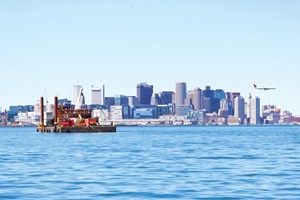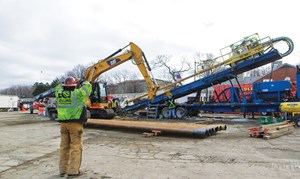January 2020 Vol. 75 No. 1
Features
Complicated Cable Boring in Boston Harbor
By Jeff Griffin, Senior Editor
ECI Drilling International (ECI) recently completed two horizontal directional drilling (HDD) installations in Boston of conduits for cable that replaced old power cable service at an essential wastewater treatment plant. The channel bore also was a step in preparing for construction of major Boston Harbor improvements.
The longest of the two bores went beneath Boston Harbor’s federal navigation channel, bringing reliable electric power to the Deer Island Wastewater Treatment Plant. The water crossing helped prepare for the start of construction on the Boston Harbor Deep Draft Navigation Improvement Project by the Army Corps of Engineers and Massachusetts Port Authority (MassPort).
The shorter bore on Deer Island completed the electric connection to the wastewater plant. This work was a New Harbor Electric Energy Company project constructed by Eversource Energy.
The Deer Island plant treats wastewater for more than 2 million customers in 43 communities, and its uninterrupted operation is critical for maintaining the ecological health of the commonwealth’s coastal waters.
Caldwell Marine International (CMI), a sister company of ECI, was awarded the contract to replace an existing cable system across Boston Harbor, from South Boston to the Deer Island plant, with 115 kV XLPE submarine cable followed by removal of the old cable system.
The project included 8,700 feet of land cable installed through duct banks and vaults in South Boston, transitioning to 15,400 feet of submarine cable under the main shipping channel across Boston Harbor, then a 1,350-foot land cable on Deer Island for connection into the Deer Island power system.
Dustin Brasher, ECI vice president/general manager, said the primary reason for using HDD was the Corps of Engineer’s minimum depth requirement for cable under areas where the deep draft project would be. For the Deer Island location, HDD minimized impact to existing utilities and eliminated disruption to the public park and access roads.
“Partnering with our sister company, CMI,” said Brasher, “ECI Drilling was selected to complete the HDD installations at both Conley Terminal and Deer Island.
Mobilization
Beginning in mid-October 2018, ECI worked with Caldwell to mobilize two, complete HDD spreads with full marine support in order to conduct both drills simultaneously. Both conduits were installed by early March 2019 and ready for the submarine cable.
“The first HDD installation extended from inside Conley Terminal in South Boston, under the main shipping channel, and exited near eel grass beds in the harbor,” Brasher explained. “The second conduit was drilled from inside of the Deer Island wastewater treatment plant, extended under public park areas and exited in the shallows of the harbor.”
Almost immediately, both drilling operations encountered extensive site condition issues, which delayed drilling approximately 90 days.
“To get back on schedule,” Brasher said, “ECI and CMI worked hand-in-hand with the owner and its engineers to redesign both HDD installations, and extended work to 24-hours-per-day, seven days a week, for several months. ECI and CMI were able to recover most of the schedule time, and both conduits were ready for installation of the submarine cable.”
The Conley Terminal HDD installation experienced several issues with the geology. The bore path was originally designed through existing fill, clay, sand and bedrock, but the crew encountered unknown, thick, cobble layers located between significantly harder bedrock and overburden formations. After multiple attempts to redirect the pilot hole through more drillable material, ECI ultimately re-routed the drill to a final elevation 35 feet below the originally proposed depth.
While drilling the pilot hole, additional geotech testing was conducted to find the prime location to exit into the seabed. A suitable exit point was determined to be 400 feet beyond the original exit point. Once the pilot was complete, ECI connected to CMI’s marine cable system and with a combination of pulling with the anchoring system, provided the pull forces necessary to forward ream the hole in a two-stage pass going to 26 inches and 36 inches, using TCI reamers.
Work began with a 330,000-pound pullback American Augers DD-330 HDD rig and later shifted to a 1-million-pound pullback HRE 1000.
“Originally we planned to use the HRE 1000 rig to complete the project,” Brasher pointed out, “but due to the project start
date and rig availability, we opted to use the American Auger DD-330 rig during the pilot and a portion of the reaming phase. An opportunity presented itself, while CMI was performing additional work, to change the DD-330 with the HRE 1000 to complete the final stages of the ream and product pullback.”
The rig was equipped with a Horizontal Technology 6 3/4, 9/10 lobe, 2.0 stage mud motor designed in-house and a 9 7/8-inch TCI bit for drilling the pilot hole. The guidance system was a Slimdrill Gyro in addition to a Horizontal Technology Hi-Resolution steering tool. The mud system and pump was an American Augers M-500 with Derrick Shaker System and onboard Kerr triplex pump.
Pipe pull
Pipe was assembled and fused on Deer Island for both HDD installations. Once completed with the final ream, a swab pass was conducted, and the pipe was successfully installed. A barge provided by CMI was used in pulling in the pipe.
With the pilot hole complete, CMI proceeded with the product pull-in from the offshore end of the conduit. Once the cable was secured onshore it was simultaneously laid and buried to a depth of 10 feet into the bottom sediments, from a cable installation barge, for a distance of approximately two miles. There, it was pulled into another HDD drilled conduit to its final destination.
“ECI utilized the marine assets with a cable pull system to keep the required pull forces on the downhole assembly, and forward reamed the bore path from the land side,” Brasher said. “This method keeps the drilling fluid returning to the entry side on-land, reducing the offshore impact and additional time required to dispose of cuttings and drilling fluids.”
The barge was equipped with a LaValley Industries Tonghand system for exit-side operations.
For the challenges of working in a marine environment with fluctuating tides, Brasher said the Tonghand provides a fast, reliable and safer alternative to traditional tongs used to make-up and break connections on the drill pipe and tooling assemblies. The additional advantage of rotating the drill pipe without assistance from the entry side reduces the possibilities of communication breakdowns and the potential for accidents.
The second drill for Deer Island had a number of delays, when previously unknown utilities were found in the area.
The drill rig used was a 100,000-pound pullback Vermeer D100x140 with onboard triplex pump. A Horizontal Technology 4 3/4, 9/10 2.0 stage in-house mud motor, with a 6 3/4-inch MT bit, and Horizontal Technology’s Hi-Resolution steering tool were used. The mud system was an American Auger M-300 with a Derrick shaker system.
According to Brasher, the bore path allowed ECI to stay within a jettable formation utilizing fly cutters for a three-ream pass of 18, 26 and 36 inches for the final hole size.
Hydro plow segment
Between the two HDD segments, an approximately 2.12-mile-long section of cable was buried to depths of 10 feet below the sea floor bottom by CMI using a hydro plow. Pre-construction surveys identified the presence of Boston blue clay along a 1,270-foot-long segment of the route to be hydro plowed, and a hydro plow could not dig a trench of needed depth (8 to 10 feet) because of the stiffness of the clay.
The burial tool is a hydraulically operated jet plow. A jet plow blade is supported between two sleds and has a multitude of jetting nozzles on its leading edge. These fluidize the soil enough that the plow can be towed forward, depositing the cable through the center of the blade and out the bottom.
“When the new cable is in operation, the existing cable will be drained of dielectric fluid and the cable removed from the seabed,” said Brasher. “Approximately 8,000-feet (1.5 miles) of the cable will be removed, corresponding to the length of the cable located within the proposed dredge footprint of the federal navigation channel, along with an additional 500-foot buffer east of the navigation channel.
“The cable will be pulled out of the sediment using a crane and winch system. If necessary, additional methods, such as jetting or mechanical dredging, may be used to remove overburden covering the cable. A remaining two-to three-mile-long section of the cable will be capped and abandoned in place.”
ECI Drilling is honored to be a part of such an important project Brasher said.
“The dedication of the entire project team and all the additional staff that it took to bring this project to completion cannot be understated,” Brasher concluded. “All involved worked diligently to provide the client with a completed product through a tough New England winter in challenging conditions, working 24-hours per day, seven days a week and through holidays.”
ECI Drilling International and Caldwell Marine International are wholly owned subsidiaries of JAG Companies. Family-owned and -operated for 40 years, JAG is ranked annually in the Top 50 largest Hispanic-owned companies in the United States. ECI has more than 27 years of experience in HDD and has completed installations in most environmental and geological formations. •
FOR MORE INFORMATION:
ECI Drilling International, (936) 441-9080, ecidrilling.com
American Augers, (800) 324-4930, americanaugers.com
LaValley Industries, (281) 444-3030, lavalleyindustries.com
SlimDril International, (281) 391-5800, www.slimdril.com
Horizontal Technology, (713) 774-5594, horizontaltech.com
Derrick Equipment Company, 866-DERRICK, derrickinternational.com
Vermeer Corp., (888) 837-6337, vermeer.com






Comments